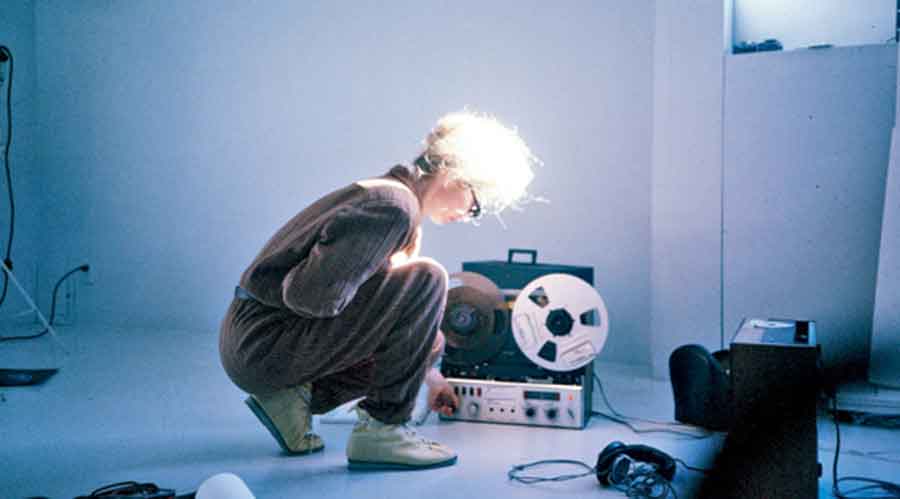The year was 1963. A musical force was being created — the theme music for Dr Who. Ron Grainer had worked on the tune to match the graphics while he had a list of noises that were required, like wind and bubbles. Though synthesisers were still a few years away, at hand was Delia Derbyshire, who had recently joined the BBC Radiophonic Workshop. Using sine- and square-wave oscillators, cutting and joining tapes, recording the results and so on, the results she delivered surprised Grainer, who wanted to give her half the royalties but BBC, back then, usually kept members of the workshop uncredited. It was a high point for machine music or what some call electronic music.
Derbyshire was a pioneer but she wasn’t alone. There was also Daphne Oram, Clara Rockmore, Bebe Barron…. All women, all pioneers and all of them used machines as tools of liberation, transforming music in their own way.
Some of these women are finally being celebrated in the documentary Sisters With Transistors, which released on Friday (on Vimeo). French-American director Lisa Rovner has spent years piecing together difficult-to-find video clips to map a thrilling story. “The film started with a grant application and then we hired an archivist and realised quite quickly that the material was going to be difficult to uncover. So I took on the challenge and did most of the archive research myself,” Rovner has told Esquire.
The story begins in the 1930s with Clara Rockmore. Trained as a violinist, Rockmore, who passed away in 1998, is best remembered as a soloist on the theremin, an early electronic instrument that produces an eerie tone. Works were written for her and she performed with the Philadelphia Orchestra and the New York Philharmonic, besides touring with Paul Robeson. Much later, in 1977, came her first album The Art of the Theremin, containing 12 numbers.


So much of it is about listening and ultimately I think that is very female
Lisa Rovner, director of Sisters With Transistors
‘The possibility of a woman composing was in itself controversial’
Laurie Spiegel, who is among the film’s subjects, has said: “We women were especially drawn to electronic music when the possibility of a woman composing was in itself controversial. Electronics let us make music that could be heard by others without having to be taken seriously by the male-dominated Establishment.”
Spiegel, who currently resides in New York, fell in love with the sound of analogue synthesisers many decades ago. In 1973, her journey at Bell Labs began where she learned to programme computers. Ultimately, one of her compositions became the “opening cut on the Golden Record”, a disc that accompanied both Voyager probes on their journey across the solar system and out into the great interstellar beyond in 1977. And then came Music Mouse, which was a programme to turn the Macintosh, Amiga and Atari computers into a musical instrument.
Sadly, women composers of electronic and computer music have not always found acknowledgement among scholars but helping their cause have been small experimental music labels which, over the years, have made some significant releases.
Had it not been for such documentaries and music reissues now and then, we wouldn’t be talking about a pioneer like Daphne Oram. The British composer and electronic musician chose to become a “music balancer” at the BBC over a place at the Royal College of Music, going on to become a co-founder of the BBC Radiophonic Workshop. She is credited with the invention of a new form of sound synthesis — Oramics. Oram learned about mixing electronics and music during the Second World War while working for the BBC on sound balance for radio broadcasts. According to Nature, during Germany’s bombings of London in the Blitz, she switched pre-recorded tracks of orchestral music into broadcasts of live music. That allowed the musicians to flee the city’s grand concert venue, the Albert Hall, without the radio audience knowing.
“So much of it is about listening and ultimately I think that is very female. I’m totally stereotyping and I’m totally happy for people not to ride with this thought. But the fact that so much of this music made by these women is about, or around... listening,” Rovner has said.
This is also a documentary which indirectly makes you want to find out more about the personalities who have been featured. Trailblazers like Derbyshire lived life their way.
In the 1970s, she became disillusioned with the electronic music scene. She wanted electronic music to have a handmade quality to it and not what synthesisers offered. Without making compromises, she withdrew from the profession and worked in an art gallery and also a bookshop. She didn’t ask for sympathy. Only after she died in 2001, 267 reel-to-reel tapes and a box of a thousand papers were found in her attic. All full of tapes, it was given as a permanent loan to the University of Manchester.
This is the story of women who have always been fascinated with the act of creation and, at the same time, were ever-encouraging. Beautifully narrated by Laurie Anderson, Sisters With Transistors is one of those rare documentaries that will sweep you off the carpet with extraordinary stories of patience and perseverance.






